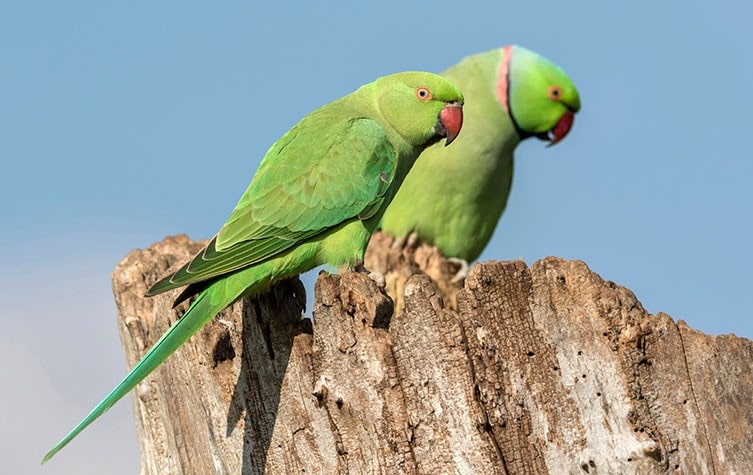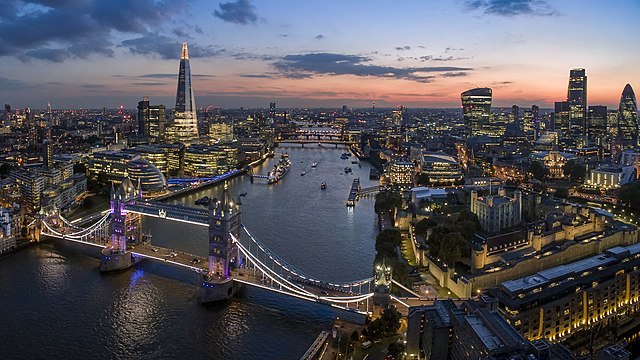Here’s an interesting piece of trivia that might fetch you a point or two in a pub quiz – the collective noun for a flock of parakeets is a ‘pandemonium’. They’ve earned that title, trust me. A parakeet’s call is a loud, high-pitched chee-chee; when a thousand of them get together for a sunset parade before settling to roost, you cannot miss them.
Not just for the sound, either. Parakeets are a brilliant green with a narrow ‘collar’ of red or black feathers and a large red upper / black lower beak. They have made themselves right at home almost everywhere in Britain – gathering in force to roost in parks and woodland at dusk, dispersing at dawn to feed on the fruits and berries in parks and orchards as well as on the feed we put out for garden birds.

They sound exotic, and they are. Parakeets are members of the parrot family originating from south-east Asia and sub-Saharan Africa, but they are one of the most successful invasive species in the world. They have established colonies across most of Europe, a large area of the United States and everywhere south of Glasgow in the British Isles. They seem to deal with the British weather very well – the hottest, driest summers and the coldest, wettest winters don’t make any serious impact on their numbers. The British parakeet population is estimated to be somewhere between 25,000 and 30,000, with the majority based around London and Kent. Two popular theories are that they are descendants of parakeets that escaped from Worton Hall Studio during the filming of ‘The African Queen’ in 1951, or of two birds released in Carnaby Street by Jimi Hendrix in the 1960’s. Well… both are nice stories but unlikely to be the whole truth.
Researchers from Queen Mary University of London compared the DNA of parakeets living wild in Britain to a global database and found that the British birds are descended from a parakeet sub-species found in Pakistan and northern India. Their conclusion was that most of their ancestors were probably pets that either escaped or were deliberately released during the health scares in the 1930’s and 1970’s about parrots and their kin passing a deadly disease called psittacosis to humans. Parakeets have been seen living wild in England since at least Victorian times – a few in Norfolk in 1855 and five in central London in 1886. Let’s face it, the parrot family is known for its intelligence; if they make up their minds to escape then they’re likely to succeed.
You may have seen wild parakeets in Essex and Suffolk, especially during the last few months. They like living near humans in the colder months. Humans make their surroundings warm and they put in a lot of effort to grow plants that provide food in autumn and winter, just as wild creatures find that their other food sources thin out – rosehips, hazelnuts, autumn fruiting raspberries, apples, sweet chestnuts and all the other plants running to seed in the flower beds and vegetable plots. You probably worried about that poor bird that suddenly appeared in your garden, thinking that it was somebody’s escaped pet struggling to survive in a cold wet winter, and you can now be happy that it is born free and doing very nicely in the wild.
In the wild is fine. Breaking and entering your home is not fine, not in the least. You won’t believe the damage a parakeet can do until you see it; large gaps pecked into fascia boards and air vents ripped away from their housing, so that the birds can get into your home before their breeding season begins in January. Once inside your loft space, they can dislodge or sever electricity cables and destroy insulation. I don’t even need to mention bird poo… these are not pleasant house-guests.

Any action you take needs to be done this month, in time to stop the parakeets from getting in;
- Check your eaves and fascia boards and have any damage repaired promptly
- If you have plastic air vents, get them replaced with securely-fixed metal ones.
- If your house has bird-box holes set into the eaves to encourage swifts and house-martins to nest, make sure the entrance holes aren’t being enlarged by a parakeet.
- Seal gaps in boarding around garages and cabins.
- Watch your fruit plants and bird feeders – parakeets are big and bold and bright green, so you’ll see them if they’re around. Make sure they aren’t flying away from the feast and on to investigate ways into the house itself.
Don’t let me keep you from enjoying the sight of our local parakeets. We could all do with some colour in our lives at this time of year. Just make sure you don’t invite them in for Christmas.

